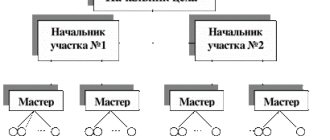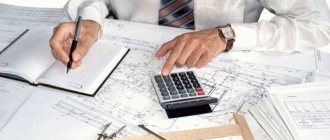About factors influencing the structure
What influences the construction of the enterprise structure
In order to correctly formulate the structure of an enterprise, it is recommended to take into account the following criteria that influence its development:
- Industry affiliation. This circumstance is influenced by the technological process and design features of the manufactured products. Moreover, the factor depends directly on the divisions of the enterprise, which differ in their areas of activity in various industries. For example, products produced at one stage are typical for the mining industry, while for the manufacturing industry this is a multi-stage industry.
- It is important to take into account the nature of the production process; it can be at the procurement stage, the processing and procurement stage. In analytical production, one or more departments can be involved simultaneously. For the synthetic process of production operations, it is planned to create several procurement workshops. In the direct production process, one or two procurement units are involved and the production unit is the processing of raw materials.
- Features of design and production technology. The approach to the quality system requires the maintenance of such units as testing laboratories, scientific and technical centers, and units created to set up production equipment. This is directly related to the high pace of modernization of manufactured products.
- Scale of production processes. The overall scale determines the size of the structure and its cost. The more production divisions, the more multifaceted its composition.
- Specialization. Subject specialization is the production of the same product by one or more departments. The technological form of specialization involves only the execution of one technical process by departments. Moreover, the greater the form of specialization, the wider the production ties.
https://youtu.be/yf83PQJThIU
Composition of the enterprise structure
The organizational structure is the full composition, subordination, interaction and distribution of work between departments.
There are several types of structures:
- Linear - the head of each department is the manager, in whose hands all plans are concentrated, subordinates are also all subordinate to him, and the interaction process is carried out along a direct chain. As a rule, this form is acceptable for small businesses.
- Functional - used for large enterprises. Organizations have separate subdivisions according to subordination.
- Linear-functional - covers simultaneously the two directions described above, while eliminating the disadvantages of both. That is, divisions carry out work on the development, production and marketing of products, and are also responsible for the results of economic activities.
Characteristics of the enterprise: a brief excursion
The general characteristics of the enterprise consist of a brief description of its registration data, organizational structure and activities.
Drawing up such a characteristic makes it possible to evaluate:
- the current state of affairs at the enterprise;
- his financial capabilities;
- effectiveness of the management team;
- the structure of the enterprise under study and its effectiveness;
- possible ways to improve the mentioned indicators.
About the classification of enterprises
Types of enterprises for various reasons
Classification of enterprises on the sales market:
- According to the characteristic features of activity: commercial - the purpose of the enterprise is to generate income, and non-profit - these include organizations engaged in charity or scientific research.
- According to the form of ownership. Private - opened by individuals, collective - activities are carried out on the basis of a collective agreement, communal - operating on the basis of territory ownership, as well as state - not subject to privatization.
- By nationality - national, foreign or mixed.
- By legal status: individual - owned by one person, cooperative - being the subject of joint economic activity, full society - if it is engaged in joint economic activity, limited liability - this is when participants bear liability equal to the amount of their contribution, joint stock - this is when the main The nuance is the security, that is, the share.
- Territorial or technological integrity is formed collectively by parent and subsidiary enterprises. Production costs are controlled by higher structures.
- By number of employees. If the number of employees in an enterprise is up to 250 people, then such enterprises are classified as small and medium-sized businesses.
Review of the activities of a construction organization
StroyDetalKonstruktsiya LLC is a commercial organization created in the organizational and legal form of a limited liability company, in accordance with the current legislation of the Russian Federation.
The Company is a legal entity and operates on the basis of the legislation of the Russian Federation and its charter. The main goal of the organization is to generate profit in the interests of the Company's shareholders.
The subject of the company's activities is to saturate the consumer market with goods and services.
The Company, in accordance with the procedure established by law, carries out the following types of activities:
— production and sale of building parts and structures;
-construction, major repairs and reconstruction of housing stock and industrial buildings and structures;
— production of consumer goods;
The Company has the right to engage in other types of activities not prohibited by law.
The company can engage in certain types of activities, the list of which is determined by law, only on the basis of a special permit (license). The right of the company to carry out activities for which it is necessary to obtain a license arises from the moment of receipt of such a license or within the period specified therein and terminates upon expiration of its validity period, unless otherwise established by law or other legal acts.
The Company's foreign economic activity is determined by the export of its own products (works, services) produced by the Company both for its own production and social needs, and to saturate the market with goods and services.
The structure of the organization's personnel corresponds to its industry specifics. At the same time, it is characterized by the need for qualified personnel with special skills.
The organizational structure of the enterprise StroyDetalKonstruktsiya LLC is a linear-functional structure (Fig. 1.1).
Rice. 1.1. Organizational structure of the enterprise StroyDetalKonstruktsiya LLC
The governing bodies of the company are:
- general meeting of participants;
The company's control body is the company's auditor.
The supreme body of the company is the general meeting of participants.
The society elects an auditor of the society. The company's auditor may be a person who is not a member of the company. An auditor of a company cannot be a person performing the functions of a sole executive body.
The sole executive body of the company is the director of the company, elected by the general meeting for a period of 2 years. The director of the company may also be elected from outside the company's participants. An agreement between the company and the director of the company is signed on behalf of the company by a person authorized by the decision of the general meeting of participants of the company.
The financial and economic department of StroyDetalKonstruktsiya LLC is a structural division of the organization. It consists of 8 employees. These include: a financial director, a financier-economist and 5 accounting employees. This division is headed by the financial director.
Analysis of the activities and financial results of StroyDetalKonstruktsiya LLC for 2012-2013. presented in the table.
The financial condition of StroyDetalKonstruktsiya LLC is determined on the basis of a general assessment of the financial and economic indicators of the enterprise. The basis for assessing the activities of the enterprise is the balance sheet for 2012–2013, presented in the table.
In the structure of sources of funds of StroyDetalKonstruktsiya LLC, equity capital predominates, its share in 2013 is 58.8%, given that in 2012 it was 12.99%. This situation indicates an improvement in the company’s financial stability in 2013. It should be noted that the structure of borrowed capital is dominated by long-term loans and borrowings, which amounted to 28.8% in 2013. In general, it can be seen that long-term loans and borrowings increase in 2013, while short-term loans and borrowings decrease. This fact indicates the organization’s expanding use of the least expensive sources of financing.
So, this financial condition of StroyDetalKonstruktsiya LLC is stable, since the proceeds from the sale of goods cover all expenses, including the cost of goods sold, products, works, services, commercial and administrative expenses, and the organization’s net profit makes it possible to pay off its obligations and develop production capacity.
In the analyzed period, changes in the value of the company's property and sources of its financing were influenced by the increase in equity capital in 2013 by 249,325.5 thousand rubles (growth rate of 580%). Fixed assets increased significantly due to the acquisition of new equipment. Consequently, own funds are the main source of formation of the company's property.
About the internal structure of the enterprise
Enterprises, as a rule, are divided into separate sections, these include workshops, departments and other divisions that interact with each other and solve joint problems.
They are classified according to several principles.
By division:
- main (those areas or workshops that are engaged in the direct production of products, and the latter determines the profile of the enterprise, as well as the sale of goods);
- auxiliary (these products are necessary for the needs of this enterprise and to meet its needs);
- side areas (organized for the purpose of recycling, manufacturing products from waste from the main production);
- and also research and experimental bureaus may be located in the general structural scheme.
If an enterprise produces simple products, then a shopless structure can be used when creating it.
At the heart of its construction is the production site and this is the largest structural unit. In general, a production site is a workplace where identical technological operations are collectively performed and uniform products are produced.
At larger enterprises, identical workshops can be combined into a single building. If the enterprise has organized a technical process, divided into cycles, then a factory-type production structure is used, that is, production tasks are carried out from the procurement stage to the release of goods.
A necessary condition for the successful operation of an enterprise is the rational construction of its production and organizational structure.
The structure of an enterprise is the composition and relationship of its internal links: workshops, sections, departments, laboratories and other divisions that make up a single economic entity.
The general structure of an enterprise (company) is understood as a complex of production divisions, organizations for enterprise management and employee services, their number, size, relationships and relationships between them in terms of the size of occupied space, number of employees and throughput.
Production divisions include workshops, areas, laboratories in which the main products (manufactured by the enterprise), components (purchased from outside), materials and semi-finished products, spare parts for product maintenance and repairs during operation are manufactured, undergo inspections, tests, and are produced. various types of energy for technological purposes, etc.
The divisions serving workers include housing and communal services departments, their services, factory kitchens, canteens, buffets, kindergartens and nurseries, sanatoriums, boarding houses, rest homes, dispensaries, medical units, voluntary sports societies, technical training departments and educational institutions, engaged in improving production qualifications, the cultural level of workers, engineering and technical workers, and office workers.
The production structure of an enterprise is a form of organization of the production process and is expressed in the size of the enterprise, the number, composition and proportion of workshops and services, their layout, as well as in the composition, number and layout of production areas and jobs within the workshops.
The main elements of the production structure of an enterprise are workshops, sections and workplaces.
The primary link in the organization of production is the workplace. The workplace is the area where the employee and the means of applying his labor are located, which is determined on the basis of technical and ergonomic standards and is equipped with technical and other means necessary for the employee to perform the specific task assigned to him.
A production site is a set of workplaces where technologically homogeneous work or various operations for the production of identical or similar products are performed. The site's products are intended for processing within the workshop.
The composition, number of sections and relationships between them determine the composition of larger production units - workshops - and the structure of the enterprise as a whole. The workshop is the main structural unit of the enterprise.
There are the following types of workshops and sections : main, auxiliary, service, secondary.
In the main workshops, a certain stage of the production process is carried out to transform raw materials into finished products or a number of stages of the production process to manufacture any product or part of it. The main shops are classified into: procurement (foundry, forging, stamping, etc.); processing (turning, milling, etc.); producing (assembly).
The task of auxiliary workshops is to ensure the normal uninterrupted operation of the main production workshops. These include: repair, plumbing, tool, energy, etc.
Service shops perform the functions of storing products, transporting raw materials, materials and finished products.
Side shops deal with waste disposal.
Specialization of workshops takes the following forms: subject, detail (unit-by-unit), technological (stage-by-stage) and territorial.
Subject specialization consists of concentrating in separate workshops the main part or the entire production process for the manufacture of specific types and standard sizes of finished products. What these various workshops have in common is a single engineering and technical service, logistics and sales of products, and storage facilities, which reduces their overhead costs.
Detailed (unit-by-unit) specialization of workshops is most common in mechanical engineering. Its essence is that each workshop is assigned to manufacture not the entire machine, but only individual parts or assemblies. All these units are transferred to the assembly shop, where the finished car is assembled from them.
Technological (stage) specialization is based on the operational division of labor between workshops. At the same time, in the process of passing objects of labor from raw materials to finished products, fundamental differences in the production technology of each workshop are highlighted. At a number of enterprises, in order to improve the quality of processing, reduce production costs or improve sanitary working conditions, one particular technological operation is assigned to individual workshops and areas.
Staged specialization of workshops and sections is widely used in almost all industries, in construction, and partly in agriculture.
Territorial specialization of production units is most typical for transport, agricultural and construction enterprises. Each workshop or site can perform the same work and produce the same products, but in different territories remote from each other. A construction organization often erects residential buildings and other structures of a similar or even the same type in different areas, at a distance of tens of kilometers from each other. In this case, it is impossible to ensure effective operational management of the construction of facilities and the delivery of labor from one center.
Therefore, to perform the same work, not one, but several construction workshops and sites are created - according to the number of objects. At the same time, the center provides the sites with the necessary machinery and equipment, construction materials, technical documentation, and also forms a portfolio of orders and conducts settlements with consumers of products, with suppliers of raw materials and materials. A similar structure of production and management is being formed in other sectors of the economy, in particular in transport, communications and repair and restoration companies.
The production structure of the enterprise is influenced by a number of factors:
— industry affiliation of the enterprise;
— the nature of the product and methods of its manufacture;
— volume of production and its labor intensity;
— level of specialization and cooperation of production;
— features of buildings, structures, equipment used, raw materials and materials.
The organizational structure of enterprise management is an ordered set of services that manage its activities, relationships and subordination. It is directly related to the production structure of the enterprise, determined by the tasks facing the enterprise personnel, the variety of management functions and their volume.
There are several types of organizational structures : linear, functional, linear-functional, divisional, adaptive.
The linear structure is characterized by the fact that at the head of each division there is a manager who concentrates all management functions in his hands and exercises sole management of the employees subordinate to him. Its decisions, transmitted along the chain “from top to bottom,” are mandatory for implementation by lower levels. He, in turn, is subordinate to a superior manager.
But this structure has a number of disadvantages, the main one of which is the need for the manager to have versatile knowledge in all areas of activity in order to be able to effectively manage the organization in the absence of specialists in the implementation of individual management functions.
A linear management structure is used, as a rule, by small and medium-sized enterprises engaged in simple production, in the absence of broad cooperative ties between enterprises.
The functional structure of management is based on the horizontal division of managerial labor. Functional managers specialize in a certain area of activity and are responsible for the implementation of relevant functions, give orders to production units on issues within their competence .
This structure does not have the disadvantages of a linear one; here issues are resolved more competently; line managers are not required to have in-depth knowledge of all aspects of production management. A major drawback of the functional structure is the violation of the unity of management and responsibility for work.
The functional management structure is usually used in large enterprises.
The linear-functional structure allows you to largely eliminate the shortcomings of both linear and functional management. With this structure, the purpose of functional services is to prepare data for line managers in order to make competent decisions or emerging production and management tasks. The role of functional bodies (services) depends on the scale of economic activity and the management structure of the enterprise as a whole. The larger the company and the more complex its management system, the more extensive the apparatus it has. In this regard, the issue of coordinating the activities of functional services is acute.
Linear-functional management structures are used in most enterprises.
Within the divisional management structure, the enterprise is divided into elements and blocks according to types of goods or services, groups of recipients or geographic regions. The divisional structure helps eliminate a number of problems that arise in a linear-functional structure. It has advantages in various industries, especially where production is poorly susceptible to fluctuations in market conditions and depends little on technological innovations, since in this structure the interaction with the external environment is still based on a mechanistic approach.
In general, the divisional structure of the organization allows it to continue its growth and effectively manage various activities and in different markets. The heads of production departments within the framework of the product or territory assigned to them coordinate activities not only “by line”, but also “by function”, thereby developing the required qualities of general management.
But within production departments there is a tendency to “shorten” goals. Due to the growth of the management apparatus due to the creation of branches, overhead costs increase. Centralized distribution of key resources in case of their shortage can lead to the development of organizational conflicts.
An adaptive management structure is characterized by weak or moderate use of formalized rules and procedures, decentralization and participation of specialists in decision making, broadly defined responsibility for work, flexibility in the power structure, and few levels of hierarchy.
Such structures are called adaptive because they can be quickly modified in accordance with changes in the environment and the needs of the organization itself.
Currently, two main types of adaptive structures are used - project and matrix.
A project structure is a temporary management body created to solve a specific problem. Its meaning is to gather the most qualified employees of the organization into one team to implement a complex project. When the project is completed, the team disbands.
In a matrix structure, along with permanent functional departments, temporary project groups are formed to solve specific problems. Members of project teams often remain in functional departments, which makes it possible to easily move personnel between projects and make better use of them.
The matrix structure also has its advantages and disadvantages. Creating a matrix organizational structure for enterprise management is considered appropriate if there is a need to develop a number of new products in a short time, introduce technological innovations and quickly respond to market fluctuations.
The organizational structure of management is not something frozen; it is constantly being improved in accordance with changing conditions. Therefore, these structures are very diverse and are determined by many factors and conditions.
The most important of them are the following:
— scale of business (small, medium, large);
— production and industry characteristics of the enterprise (production of goods, services, purchase and sale);
- nature of production (mass, serial, single);
— sphere of activity of firms (local, national, foreign market);
— level of mechanization and automation of management work;
— qualifications of workers.
Divisions for specialization of technical processes
Classification of enterprise divisions by specialization
The workshops are also divided by specialization, namely:
- technological (that is, the enterprise produces serial or single products, and the range of products may be different, depending on the degree of complexity);
- subject structure (production is made for a certain type of product or individual components, blanks and other goods, used for mass and large-scale production, and product output may be limited);
- mixed (at the same time, some divisions are engaged in the production of subject-specific products, and another part - specialized).
ELEMENTS OF PRODUCTION STRUCTURE
Workplace
A workplace is a part of a production area equipped with the necessary equipment, tools and materials for the employee to perform the assigned task. Workplaces must be interconnected; most often they are placed sequentially in the production space.
Types of jobs depending on the number of performers:
- individual (one workplace - one performer);
- collective (one workplace - several performers).
The organization of workplaces must comply with a number of technical requirements of personnel and the requirements of correct working conditions, therefore workplaces are subject to certification.
All workplaces are subject to a service system:
- delivery of materials (tools);
- export of finished products;
- adjustment and repair of equipment;
- product quality control (carried out by the technical control department).
Production areas
Workplaces are combined into production areas. Each site is assigned a team of workers (7–12 people) and a site manager (senior foreman, foreman).
Teams are formed based on the specialization of workers, that is, one team includes workers of the same and/or related professions engaged in homogeneous technological processes. Brigades can also be formed in complexes - from workers of different professions to perform homogeneous technological processes.
Concentration and specialization are the principles of organizing production sites. Based on these principles, the following types of production sites are distinguished:
- technological section (specialization of the section by type of work). The technological area is characterized by the same type of tools and equipment and a certain (homogeneous) type of work. Examples of technological areas include foundry, galvanic, thermal, grinding areas, areas of turning and milling machines, etc.
The technological area is characterized by high equipment load and high production flexibility when developing new products or changing production facilities. At the same time, there are difficulties with planning, the production cycle is lengthened, and responsibility for product quality is reduced. The technological type is recommended for use when producing a large range of products and when their production is low;
- subject area (specialization by type of product). Examples of subject areas: a section of specific parts, a section of shafts, transmissions, gearboxes, etc. A subject area is characterized by a high concentration of all work within one area (increases the responsibility of performers for the quality of products). This area is very difficult to reconfigure for other products when developing a new type or reorienting an enterprise.
The item type is recommended for use when producing one or two standard products, with a large volume and high stability of output. With the object type, processing of a batch of parts can take place in parallel on several machines performing successive operations;
- subject-closed section (specialization by type of product, a complete cycle of product manufacturing is carried out). Various types of equipment are used here, and workers of different professions work here. The subject-closed section allows you to reduce the duration of the production cycle and simplify the planning and accounting system. As a rule, equipment of the subject-closed type is placed along the technological process, as a result of which simple connections are organized between workstations.
Production workshops
All production areas are grouped in a certain way and are part of workshops. It should be noted that production workshops are not formed at all enterprises. If the enterprise is small and the production volume is low, then only production areas are created on it (shopless structure). As a rule, all production departments are headed by department heads by name or number (head of the assembly department or head of department 1).
All workshops of the enterprise are divided into categories depending on the type of production process:
1) basic . In workshops of this type, production processes are assumed, during which the main products of the enterprise are produced;
EXAMPLE
At mechanical engineering enterprises, the main production includes three stages: procurement, processing and assembly.
The procurement stage includes the processes of obtaining blanks: cutting of materials, casting, stamping. The processing stage includes the processes of turning blanks into finished parts: machining, heat treatment, painting, electroplating, etc.
The assembly stage is the final part of the production process. It includes the assembly of components and finished products, adjustment and debugging of machines, instruments, and their testing.
2) providing . These workshops involve production processes for the manufacture of auxiliary products required for the main workshops. Examples of supply shops can be tool shops, repair shops, energy facilities, etc.;
3) serving . In workshops of this type, production processes are assumed, during the implementation of which services are performed that are necessary for the normal functioning of both main and auxiliary production processes. Examples of service workshops include transportation, storage, parts assembly, construction workshops, etc.;
4) auxiliary - carry out the extraction and processing of auxiliary materials (containers, packaging, mining, etc.);
5) by-products - they make products from production waste (for example, a waste recovery workshop);
6) auxiliary - in workshops of this type, processes are assumed to ensure the uninterrupted flow of the main production processes. Examples of auxiliary workshops include workshops for equipment repair, equipment manufacturing, area cleaning, etc.
Types of production structure of main workshops
Depending on the type of specialization, the following types of production structure of the main workshops are distinguished:
- technological type of workshop . In this case, the workshop specializes in performing certain homogeneous production processes (for example, foundry, assembly, etc.);
- subject type . The workshop specializes in the manufacture of a certain type of product or part of it. The result of the activity of a given workshop can be a finished product (in this case, the type will be called subject-closed);
- mixed ( subject-technological ) type . Most often, procurement processes have a technological structure, while processing and prefabricating processes have a subject (subject-closed) structure. In this way, a reduction in the cost per unit of production is achieved by reducing the production cycle and increasing labor productivity.
Based on the material reviewed, let us present the typical production structure of an enterprise in the form of a diagram (Fig. 1).








